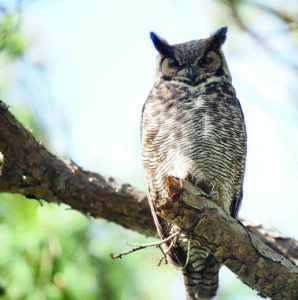(Editor’s note: Suzette Stitely is a member of the Talbot Bird Club and travels extensively for birdwatching.)

The Great Horned Owl is widespread across North America and is more common on the Eastern Shore than many realize. (Photo courtesy Suzette Stitely)
One of our local birds more often heard than seen is the Great Horned Owl. If you are very lucky, you may even have one nesting in your yard.
The Great Horned Owl is widespread across North America and is more common on the Eastern Shore than many realize. They are a resident species and do not migrate.
The Great Horned Owl is a large, dark brown bird with ear tufts, yellow eyes, and a white bib.
They sit erect when perched and both sexes look similar.
You will hear the male Great Horned Owl begin territorial hooting for a mate by early October. It’s a deep, resonate “who, hoo, hoo, hoo, hooooo. ”
Once females begin answering, their reply is at a higher pitch. Their duet is a beautiful, haunting song heard all winter and ending when eggs are laid. Great Horned Owls make screams, hisses, coos and shrieks. Interestingly, the males’ territorial hooting is unique to each bird and sonograms can be used to identify individuals.
Great Horned Owls use more nest sites than any other bird in the Americas, but most commonly they use the nest of other species. In our area, they will use the nest of Red-tailed Hawks, crows, ravens and squirrels.
The nest can be well-protected or totally exposed to the elements. Most nests are only used for one season.
Up to four dull white eggs are laid and incubated for about five weeks by the female.
Since hatching occurs in winter, the female rarely leaves the nest for the first few weeks and is fed by the male.
Nestlings develop quickly and are ready to fledge at six weeks old.
They stay near the nest and are able to fly well after another five weeks. Juveniles stay with their parents all summer and their begging screams are commonly heard at night.
It’s beneficial to have Great Horned Owls around as their diet consists mainly of small rodents.
They will also capture rabbits and other birds. Because they will take the nestlings of other birds, Blue Jays and crows will typically “mob” any Great Horned Owl they find.
If you want to see a Great Horned Owl, follow the cries and flights of the jays and crows and they may lead you directly to the owl.
While survival rate has many factors, food abundance seems to have the most effect.
They can also be infected with West Nile Virus and poisoned by eating rodents contaminated with rodenticides.
Great Horned Owls can live 20 years or more in the wild, although it appears populations are declining.
Learn more about birds, including the Great Horned Owl, by joining the Talbot Bird Club.
The Talbot Bird Club welcomes anyone who has an interest in birds, whether a novice or experienced ornithologist, and whether you enjoy watching birds at your feeder or traveling throughout the world.
Our members learn from one another and are willing to share their knowledge.
The Talbot Bird Club is part of the Maryland Ornithological Society and also has a Facebook page.



